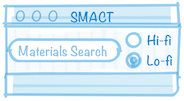Stoichiometry Screening: Getting the Ratios Right#
You’ve learnt to navigate vast chemical spaces, apply intelligent filters, and map entire compositional systems. Now comes a crucial question: Once you know which elements to combine, how many atoms of each should you use?
This is where stoichiometry screening comes in - the systematic exploration of different atomic ratios to find chemically viable compounds.
Compositional vs. Stoichiometry Screening#
Let’s clarify the distinction with an example:
Compositional Screening asks: “Should I combine Cu, Ti, and O?”
Explores which elements from the periodic table to use
Maps entire chemical systems like Cu-Ti-O
Generates phase diagrams of elemental combinations
Stoichiometry Screening asks: “Given Cu, Ti, and O, should I make CuTiO₃, Cu₂TiO₄, or CuTi₂O₅?”
Explores different atomic ratios for known element combinations
Applies chemical rules to validate specific stoichiometries
Finds all possible ratios that satisfy charge neutrality and oxidation state rules
Why Stoichiometry Matters#
Consider the difference between these copper oxides:
Cu₂O (cuprous oxide): red, semiconducting, used in solar cells
CuO (cupric oxide): black, different band gap, different applications
Same elements, different stoichiometry, completely different properties! Getting the atomic ratios right is crucial for materials design.
The Challenge: Stoichiometric Explosion#
Even with just 3 elements, the number of possible stoichiometries grows rapidly:
Maximum coefficient 2: CuTiO, Cu₂TiO, CuTi₂O, CuTiO₂, Cu₂TiO₂, etc.
Maximum coefficient 8: Hundreds of possibilities
Most are chemically impossible: Violate charge neutrality or oxidation state rules
Without systematic screening, you might waste time on compositions that can never exist.
What You’ll Learn#
In this section, we’ll explore:
1. Systematic Stoichiometry Generation#
How to enumerate all possible atomic ratios
Setting reasonable limits on stoichiometric coefficients
Organising the search space efficiently
2. Chemical Validation Rules#
Charge neutrality: Why CuO works but Cu₃O₇ doesn’t
Oxidation state compatibility: Using real database statistics
Electronegativity ordering: Predicting which ratios are stable
3. Targeted Structure Types#
Binary compounds: Simple AB ratios
Ternary perovskites: ABX₃ stoichiometries for functional materials
Quaternary systems: Complex multi-element ratios
4. Real-World Applications#
Pre-synthesis screening to save lab time and resources
Computational study planning to focus DFT calculations
Database-informed design using ICSD occurrence statistics
Building on Previous Knowledge#
This section directly builds on your previous learning:
Chemical Filters provide the validation rules we apply
Compositional Screening identified promising element combinations
Stoichiometry Screening now finds the optimal atomic ratios
The ICSD Connection#
A key innovation in this section is using real crystallographic data from the ICSD (Inorganic Crystal Structure Database) to inform our screening:
O²⁻ appears in 116,910 structures (very common and stable)
Li⁵⁺ appears in 0 structures (impossible oxidation state)
This data guides us toward chemically reasonable combinations
Practical Impact#
Stoichiometry screening can reduce your experimental workload dramatically:
Without screening: Try dozens of compositions randomly
With screening: Focus on the 5-10 most promising ratios
Result: Faster discovery, fewer failed experiments, better materials
What’s Next#
By the end of this section, you’ll have the tools to:
Systematically explore stoichiometric spaces for any element combination
Apply evidence-based chemical rules to validate compositions
Visualise results with interactive plots and grids
Integrate your findings with experimental and computational workflows
Ready to master the art of atomic ratios? Check out the stoichiometry screening follow along!
